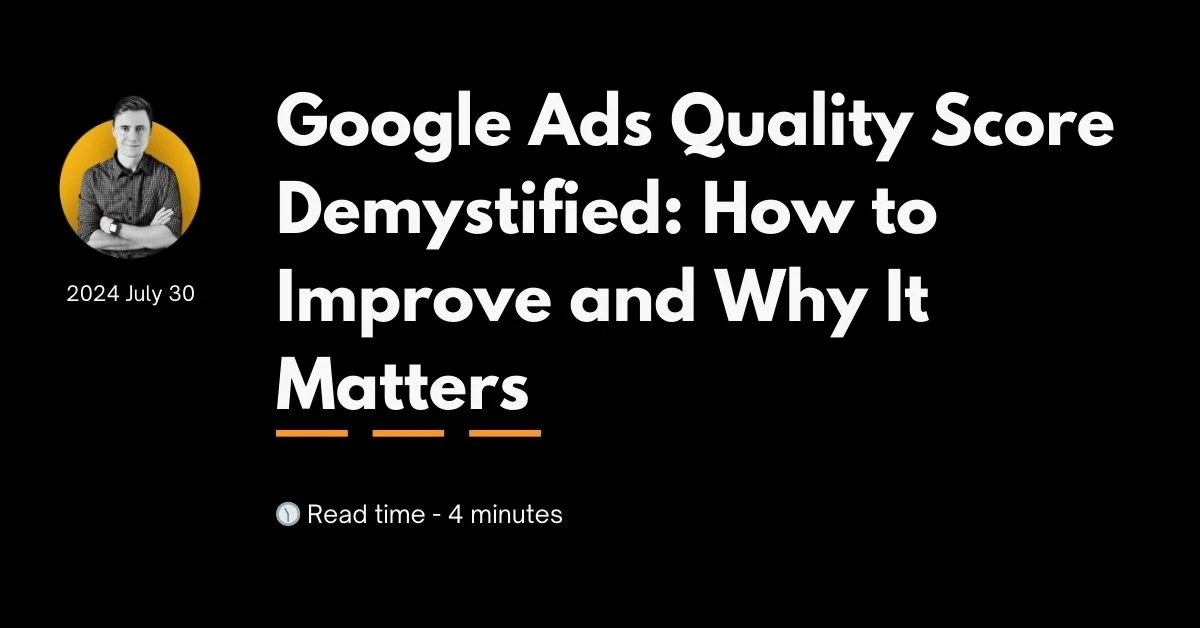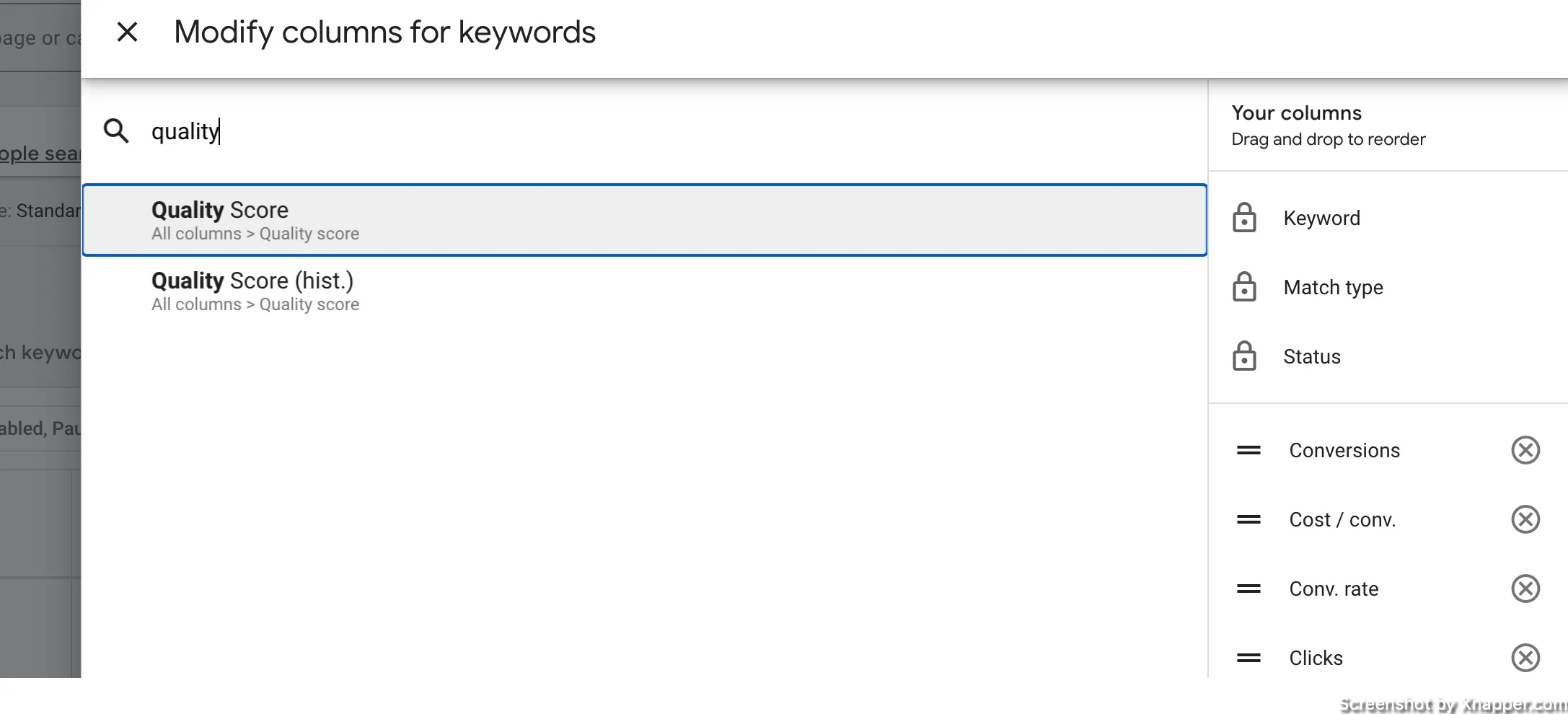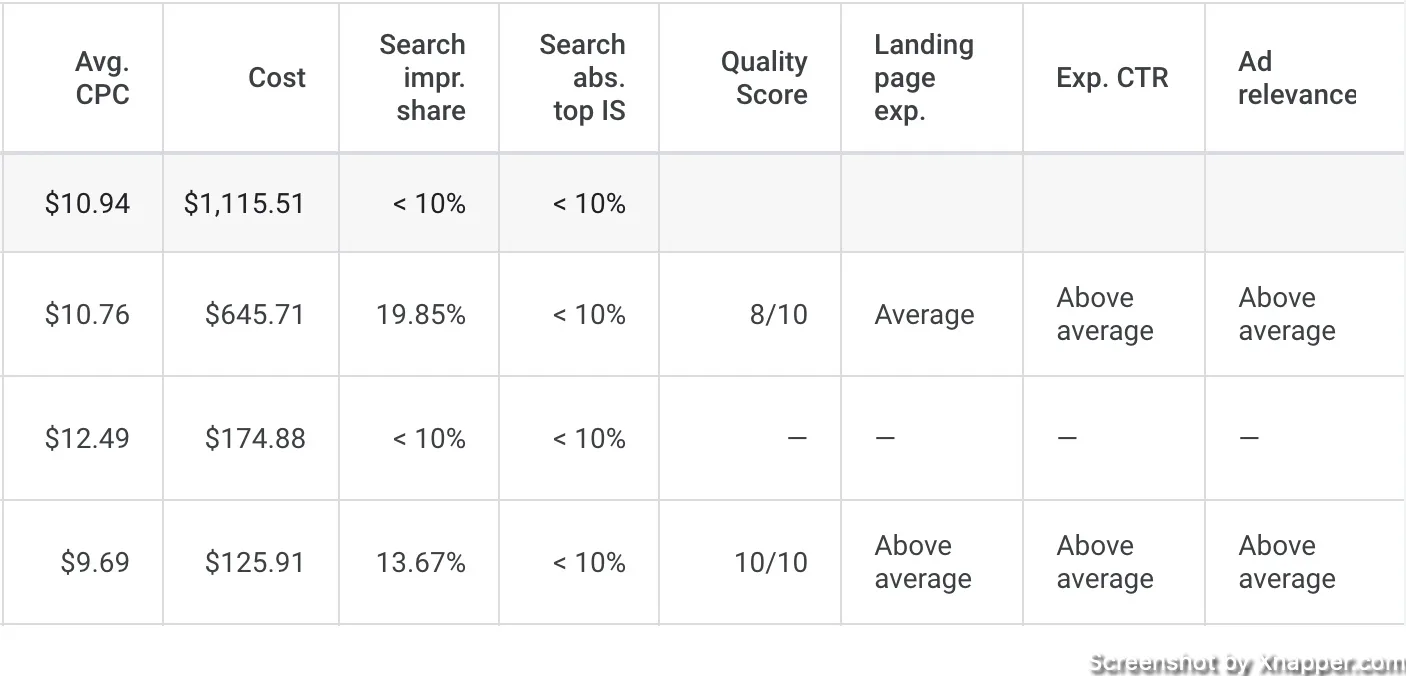
Quality Score is crucial. It decides how often your ad shows and the cost per click. Think of it like school grades. Higher scores mean better perks.
Ever wonder what’s behind the score?
We’ll explore its components, importance, and improvement methods. We’ll check ad relevance and page experience.
What is a Quality Score?
Many say that Quality Score doesn’t work and you should not focus on it. Sure, it’s not your main metric, but it does help. That’s why your ad will not be shown due to low Quality Score.
Quality Score is a tool that shows how your ad quality stacks up against others. It’s rated from 1 to 10 and can be seen at the keyword level. A higher Quality Score means that your ad and landing page are more relevant and useful to people searching for your keyword.
Quality Score is calculated based on the performance of these 3 components:
Expected clickthrough rate (CTR): The likelihood that your ad will be clicked when shown.
Ad relevance: How closely your ad matches the intent behind a user’s search (think your keywords)
Landing page experience: How relevant and useful your landing page is to people who click your ad. The page has to match your keywords’ intent.
Historical performance does have some impact, but it’s low. Google compares all 3 components to other advertisers whose ads showed for the exact keyword over the last 90 days. Then, it assigns a status: “Above average,” “Average,” or “Below average.”
Here’s why it’s a big deal:
Helps your ad show up more: Google wants everyone to find what they’re looking for, so if your ads are really helpful and people click on them often (click-through rates), Google will show your ad more.
Saves you money: When your score is high, you don’t have to spend as much to get your ad to show up. It’s like getting a discount because you did a good job!
Better spot on the page: Just like sitting at the front in class lets you see better, a high Quality Score can put your ad at the top of the search page, higher than your competitors with lower scores.
Keeps users happy: User experience matters. Having users find what they want is beneficial for you as a business owner.
💡Changing match types will not impact your QS. Quality Score is based on historical impressions for exact searches of your keyword, therefore changing keyword match types will not impact Quality Score.
💡 Sometimes, you may see a broad match keyword with QS even though there are no impressions. This means that there is an exact match keyword with impressions over the last 90 days. In this case, the QS for both will be the same.
If you don’t see a Quality Score near a keyword, this means there are not enough searches that exactly match your keyword to determine QS. You may see “–”
There are more factors related to ad quality that are not captured by the Quality Score. This may sound strange, but I think Google does it to hide the true formula and, at the same time, have a bit of influence on CPC (we all heard the case against them manipulating auction prices).
Having said that, additional factors may include:
- Devices used in search
- Location of user
- Time of day
- Assets
How to add a Quality Score column?
When you’re in your keywords view, click on modify columns and search for Quality Score. Add it.

Along with the Quality Score, you want to enable additional columns: Landing page experience, Expected CTR, and ad relevance.

This gives you a better view of how Google sees your keywords, landing page, and ads. You can save this column layout so you don’t have to change it every time.
Look through the keywords that have low Quality Score and check if the other 3 columns are below average. If you have a QS of 8 and above, you shouldn’t focus on that anymore. Leave it and fined something better to do.
Don’t make it your goal to have 10/10. But make sure you don’t have low QS keywords. By low, I mean lower than 5.
How to increase Quality Score
What can you do to increase the quality score if it is low?
- Make your ads relevant.
- Increase your CTR
- Create great landing pages
Ad relevance
Your ads should be relevant to your keywords. And at the same time, your landing page should be relevant to the ad and the keywords. That’s why having a good campaign structure is important. It seems like a forgotten art.
Ad relevance is making sure you get help for exactly what you ask for. If someone searches for “cool sneakers,” and your ad talks about “cool sneakers,” that’s super relevant! I talk a lot about keyword structure in my book, and if you nail that, you should be fine with keyword and ad relevancy.
Your ads have to use the right words that match what folks are searching for. Using words that are closely tied to what you’re selling and what people want is key. This makes everyone happy – the people get what they are looking for, and you get a thumbs up from Google with a good grade on ad relevance.
Expected click-through rate (CTR)
Expected CTR is like a guess about whether people will think your ad is worth looking at and will want to learn more by clicking on it. It’s a bit like guessing how many people will want to come to your birthday party. Google guesses this by looking at how your ad performed in the past – did a lot of people click on it before?
If your ad is really interesting or has words that grab attention, more people will want to click. This doesn’t mean you should trick them with fancy words that don’t match what you’re selling. Be honest and exciting, and you could see your CTR grade go up.
Make sure to match ads to your keywords. That is a major factor affecting CTR.
Landing page experience
After someone clicks on your ad, they land on your webpage – that’s your landing page. This is your chance to make a new friend by making sure they have a good time. If your page loads quickly, looks nice, is easy to read and use, and it gives people what they were promised in the ad, they’ll probably like it.
Google checks if your landing page is friendly for computers and phones, has clear information, and helps people do what they came to do—maybe buy something or sign up. If you do all this well, your landing page experience score can make both visitors and Google very happy!
The most important part is the first impression. People have to understand that they landed on the correct page. Make sure the title relates to your ad and keywords. A small hack is to use similar keywords on the landing page. It’s similar to SEO, but less complicated.
You might not have a lot of control over them due to many reasons, like not having a developer. Just make sure that it loads fast, is mobile-optimized, and has enough content on the page for Google to see its relevancy to the keywords.
I want to stop here because I don’t want you to make it your mission to have a score of 10 for all keywords. This is not needed and is sometimes impossible. Only do something if your main keywords have a low-quality score.
Negative Keywords
Additionally, you can work on negative keywords. Carefully manage your negative keyword list to avoid wasted spend on unhelpful traffic. This saves your budget for high-quality impressions. By focusing on such aspects of Quality Score, you are more likely to increase your ad’s impressions and visibility in Google Ads.
You can add those columns to understand which keywords might need some optimization.

By doing these things, not only do you make Google happy, but people also enjoy visiting your website, and that can lead to more sales.
Remember, always be honest and clear with what you’re offering, and Google will likely give you that high-five by increasing your Quality Score. Keep working on it, and it can help your ads do better without spending extra money.
Common Misconceptions about Quality Score
You can find online a lot of information and some of it is not entirely accurate. There are many reasons for it, but it’s not our problem. Let’s address some of the misconceptions people have around Quality score.
It’s Not Just Your Clickthrough Rate (CTR)
Even though how often people click on your ads is important, it’s not the only thing that matters. Google also looks at how relevant your keywords are, and what kind of experience people have on your landing page.
One-time Thing
Quality Score isn’t something that is set once and never changes. It updates regularly, but not every second of the day. So, if you make your ads better, your score can go up over time.
Directly Tied to Ad Cost
A good Quality Score can mean you pay less for your ad to be shown, but it’s not the only factor. There’s more to it, like how much competition there is for the words you want to use in your ads.
Impact of changing match types
This is a common one. Quality Score is based on historical impressions for exact searches of your keyword, therefore changing keyword match types will not impact Quality Score.
Impact of pausing ads/keywords
If you decide to pause your ads or keywords, here’s what can happen:
- No Immediate Effect on Quality Score: Pausing your ads or keywords doesn’t hurt your Quality Score right away. Your score stays the same until you start your ads again.
- Historical Performance Matters: When you unpause, Google remembers how your ads did before. If they were doing well, you’re still in a good spot.
- Start-Up Again Carefully: If things have changed (keywords, ads, landing page, competition) while your ads were paused, you might need to make some adjustments to keep a good Quality Score.
Device Does Matter
The user’s device is taken into account when ad quality is calculated. This is especially important for mobile devices and the load times. Check your Google Page insights to see if you have any problems with your website.
User’s Intentions
Ads quality hinges on relevance to users’ searches and intentions. Ads and sites that aid in finding information, completing tasks, or making purchases rank higher. Thus, we recommend focusing on relevant ads to answer search queries, rather than trying to game the system for a better score.
New keywords performance based on existing keywords
Google will try to look at your existing keywords to determine the Quality Score of your new keywords. So if your keywords, landing pages and ads are in a good shape, you should be fine with new keywords as well.
But that’s at the start. Once enough data is gathered, it will be used to evaluate your newly added keywords.
Account structure
It doesn’t matter how you structure your account. Let me clarify this. How you group your keywords matters, as you write ads to those keywords. However, how you name your campaigns and ad groups or how many you have, does not.
There is no account-level, campaign-level, or ad group-level Quality score.
Also, if you move keywords around into different ad groups or campaigns, their Quality Score does not change. But if something changes (ads, landing pages), that could affect your Quality Score.
Running other campaign types
Don’t worry about running Display ads, Search partners, or whatever. These campaigns dot no impact your Quality Score in your Search campaigns.
Ad position does not matter
Higher ad positions usually get higher CTRs as they are above other results. However, these numbers are normalized and do not affect your Quality Score. You don’t need to bid higher to be placed in the higher position, thinking it will impact your Quality Score.
Whenever you’re ready, there are 3 ways I can help you:
- Book a call with me. During a 1-hour call, we can go through your account and identify growth opportunities or do a quick audit to see what can be improved instantly. Short call, big gains.
- Get my book “The Google Ads Playbook”. It’s almost 300 pages on how to create, manage and optimize campaigns. If you’re just starting out, you will get massive value out of it. No fluff. No BS. No basic information. Nothing held back.
- Subscribe to my FREE weekly newsletter. Don’t miss new articles. Get them straight into your inbox.
I share weekly tips on how to create, manage, and scale Google Ads campaigns. Subscribe to my free newsletter.
I’m also down with connecting on LinkedIn.
Or follow me on X, for some quick updates and fast insights.